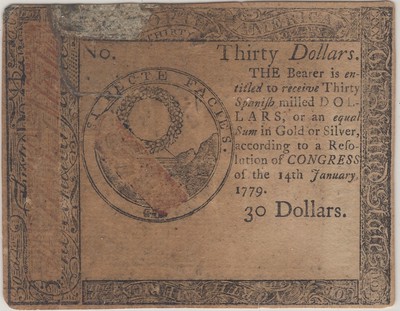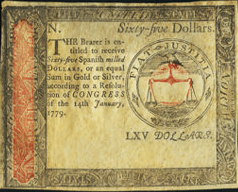
PREV ARTICLE
NEXT ARTICLE
FULL ISSUE
PREV FULL ISSUE
QUERY: CONTINENTAL CURRENCY REMAINDERS?Ray Williams writes: "I see no reason to call Bruce Vogel's Continental Currency a "Test Note". I think it is more likely what we call a "remainder", notes that are printed and either not signed or partially signed." I asked, "How common are remainders for colonial currency? Not sure if I ever heard of or saw one." -Editor Ray responded: "Now that you mention it, I don't remember a Continental Currency remainder. But I haven't looked for one. There were certainly overruns printed in case of damage or problems. It is assumed overruns were destroyed after the full authorized number had been successfully signed. I've seen a number of them for colonies and states. You do raise a good question." Ron Haller-Williams writes: "I thought I would try playing around with the brightness and contrast, from your best image of the face of the note. And it seems there's definitely SOMETHING there, though I don't know what!" Interesting approach. I can sorta see some letters there, but nothing is even close to clear. -Editor Ray adds: "Unfortunately, Eric Newman lists the signers of Continental Currency alphabetically. You sometimes need to go thru hundreds of names to try to identify a name that is only partially visible." Ray has a list of signers by issue date. If someone thinks they can ID a signature if they knew what to look for, I can forward this to you. -Editor Stu Levine writes: "I think it's just a damaged note. I’m sure that Eric P. Newman would have recognized it as a damaged note also. No remainders of Continental Currency are known. I've never heard of a "test note", nor during our thousands of discussions regarding Colonial Currency did Eric P. Newman and I ever discuss anything referred to as a "test note." One-sided proofs exist. Eric owned a $65 obverse impression. Counterfeit detectors also exist. This item is not one of those either." Len Augsburger writes:
"Last week’s anecdotal report of a Continental Currency test note requires clarification. Known variants of Continental Currency include proofs (one-sided) and counterfeit detectors (two-sided, on blue or pink paper). Newman further mentioned a
Link to January 14, 1779 $65 Two Color Face Proof in Newman VII:
Thanks, everyone! -Editor
To read the complete article, see:
THE BOOK BAZARREWayne Homren, Editor The Numismatic Bibliomania Society is a non-profit organization promoting numismatic literature. See our web site at coinbooks.org. To submit items for publication in The E-Sylum, write to the Editor at this address: whomren@gmail.com To subscribe go to: https://my.binhost.com/lists/listinfo/esylum All Rights Reserved. NBS Home Page Contact the NBS webmaster 
|


